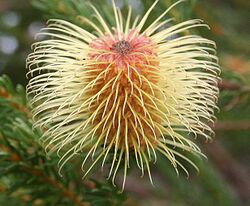Biology:Banksia subser. Longistyles
| Banksia subser. Longistyles | |
|---|---|

| |
| Banksia pulchella (Teasel Banksia), the type species of B. subser. Longistyles | |
| Scientific classification | |
| Kingdom: | Plantae |
| Clade: | Tracheophytes |
| Clade: | Angiosperms |
| Clade: | Eudicots |
| Order: | Proteales |
| Family: | Proteaceae |
| Genus: | Banksia |
| Subgenus: | Banksia subg. Banksia |
| Section: | Banksia sect. Oncostylis |
| Series: | Banksia ser. Abietinae |
| Subseries: | Banksia subser. Longistyles K.R.Thiele |
Banksia subser. Longistyles is a valid botanic name for a subseries of Banksia. It was published by Kevin Thiele in 1996, but discarded by Alex George in 1999.
Cladistics
The name came about after a cladistic analysis of Banksia by Thiele and Pauline Ladiges yielded a phylogeny somewhat at odds with the accepted taxonomic arrangement, prompting them to publish a revised arrangement. Their cladogram contained clade a consisting of B. tricuspis (Lesueur banksia) and all of the taxa in George's B. ser. Abietinae, implying that George's B. ser. Abietinae could be rendered monophyletic by transferring B. tricuspis into it. This clade resolved into four subclades, for which Thiele published four corresponding subseries. B. subser. Longistyles was based upon the second subclade:[1]
|
B. violacea | |||||||||||||||||||||||||||||||
| |||||||||||||||||||||||||||||||
Taxonomy
B. subser. Longistyles was formally defined as containing those taxa with very long and slender styles, and with smoothly convex perianth limbs without a costal ridge and with thickened margins. The epithet Longistyles is from the Latin longus ("long") and stylus (style).[1]
Although the nearest outgroup of B. subser. Longistyles was the clade corresponding to B. subser. Nutantes, the subseries was placed after all the other subseries in Thiele and Ladiges' taxonomic arrangement. The placement and circumscription of B. subser. Longistyles may be summarised as follows:[1]
- Banksia
- B. subg. Isostylis (3 species)
- B. elegans (incertae sedis)
- B. subg. Banksia
- B. ser. Tetragonae (4 species)
- B. ser. Lindleyanae (1 species)
- B. ser. Banksia (2 subseries, 12 species)
- B. baueri (incertae sedis)
- B. lullfitzii (incertae sedis)
- B. attenuata (incertae sedis)
- B. ashbyi (incertae sedis)
- B. coccinea (incertae sedis)
- B. ser. Prostratae (8 species)
- B. ser. Cyrtostylis (4 species)
- B. ser. Ochraceae (3 species, 2 subspecies)
- B. ser. Grandes (2 species)
- B. ser. Salicinae (2 subseries, 11 species, 4 subspecies)
- B. ser. Spicigerae (3 subseries, 7 species, 6 varieties)
- B. ser. Quercinae (2 species)
- B. ser. Dryandroideae (1 species)
- B. ser. Abietinae
- B. subser. Nutantes (1 species, 2 varieties)
- B. subser. Sphaerocarpae (4 species, 2 varieties)
- B. subser. Leptophyllae (4 species, 2 varieties)
- Banksia subser. Longistyles
- B. violacea
- B. laricina
- B. incana
- B. tricuspis
- B. pulchella
- B. meisneri
- B. m. var. meisneri
- B. m. var. ascendens
Thiele and Ladiges' arrangement remained current only until 1999, when George's treatment of the genus for the Flora of Australia series of monographs was published. This was essentially a revision of George's 1981 arrangement,[2] which took into account some of Thiele and Ladiges' data, but rejected their overall arrangement. B. subser. Longistyles was discarded, and B. tricuspis once again removed from B. ser. Abietinae.[3]
Recent developments
Since 1998, Austin Mast has been publishing results of ongoing cladistic analyses of DNA sequence data for the subtribe Banksiinae. His analyses suggest a phylogeny that is rather different from previous taxonomic arrangements. Although B. ser. Abietinae is largely monophyletic, B. subser. Longistyles apparently is not, as its members fall into three widely separated clades.[4][5][6]
Early in 2007 Mast and Thiele initiated a rearrangement of Banksia by transferring Dryandra into it, and publishing B. subg. Spathulatae for the species having spoon-shaped cotyledons. All members of subseries Longistyles with within Mast and Thiele's B. subg. Spathulatae, but nothing further has been published. Mast and Thiele have foreshadowed publishing a full arrangement once DNA sampling of Dryandra is complete.[7]
References
- ↑ 1.0 1.1 1.2 Thiele, Kevin; Ladiges, Pauline Y. (1996). "A Cladistic Analysis of Banksia (Proteaceae)". Australian Systematic Botany 9 (5): 661–733. doi:10.1071/SB9960661.
- ↑ Template:The genus Banksia L.f. (Proteaceae)
- ↑ George, Alex S. (1999). "Banksia". in Wilson, Annette. Flora of Australia. 17B: Proteaceae 3: Hakea to Dryandra. Collingwood, Victoria: CSIRO Publishing / Australian Biological Resources Study. pp. 175–251. ISBN 0-643-06454-0.
- ↑ Mast, Austin R. (1998). "Molecular systematics of subtribe Banksiinae (Banksia and Dryandra; Proteaceae) based on cpDNA and nrDNA sequence data: implications for taxonomy and biogeography". Australian Systematic Botany 11 (4): 321–342. doi:10.1071/SB97026.
- ↑ Mast, Austin R.; Givnish, Thomas J. (2002). "Historical biogeography and the origin of stomatal distributions in Banksia and Dryandra (Proteaceae) based on Their cpDNA phylogeny". American Journal of Botany 89 (8): 1311–1323. doi:10.3732/ajb.89.8.1311. ISSN 0002-9122. PMID 21665734.
- ↑ Mast, Austin R.; Jones, Eric H.; Havery, Shawn P. (2005). "An assessment of old and new DNA sequence evidence for the paraphyly of Banksia with respect to Dryandra (Proteaceae)". Australian Systematic Botany (CSIRO Publishing / Australian Systematic Botany Society) 18 (1): 75–88. doi:10.1071/SB04015.
- ↑ Mast, Austin; Thiele, Kevin (2007). "The transfer of Dryandra R.Br. to Banksia L.f. (Proteaceae)". Australian Systematic Botany 20: 63–71. doi:10.1071/SB06016.
Wikidata ☰ Q4856743 entry
 |

